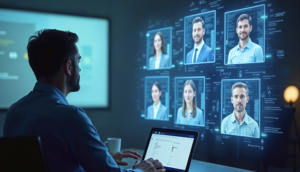In a world where B2B lead generation, demand generation, and marketing, in general, are more data-driven than ever before, intent data is essential. B2B intent data will help you identify higher quality leads by helping you better understand your target audience. This information goes beyond simple demographics and firmographics data, and aids you in targeting B2B customers that are searching for relatable products or services.
In the 2018 ABM Benchmark Survey Report by Demand Gen, it was shown that only about a quarter of B2B businesses use intent data and monitoring tools. However, 35% said that they are looking to implement it within the next year. The rise in interest in using B2B intent data is due, in large part, to its successful use by other sales and marketing teams in delivering personalized ads and campaigns to leads that are most likely to be responsive. Intent data has helped many B2B companies connect with the right stakeholders and decision-makers within target accounts by providing them with valuable, useful content that attracts and converts.
In the end, all sales reps want to interact with prospects that are actively searching topics related to your products and services, instead of simply hoping that they are. So, what exactly is intent data, and what is the best way to leverage it?
What Is B2B Intent Data?
In its simplest form, intent data shows when a prospect or account/company exhibits all the telltale signs of their intention to buy in the near future. Most B2B buyers will do their research and due diligence in researching products and potential suppliers beforehand. Statistically, 67% of the buyer’s journey today is done digitally and 57% of the purchase decision is complete even before the customer makes contact with a supplier for the first time.
Intent data tends to come in two forms:
- Internal Intent Data: Also known as first-party data, internal intent data is generated based on the activities and engagements prospects have with your own digital content. The “contact form” is one such example. But everything else, from website visits, opened emails, downloaded ebooks, and white papers, to the social media links they click on, is considered to be part of first-party data. All of this information will let your marketing and sales teams know that prospects are interested in what you have to offer.
- External Intent Data: This type of information is available mostly through third-party providers and is generated by your prospects’ engagement with content on the internet. Like first-party intent data, third-party data is collected with tracking cookies but focuses on customer actions, like reading industry-specific articles and publications, watching webinars, discussing industry-specific topics on social media, following specific brands and influencers, other actions.
A special mention should be given to bidstream data (non cookie-based, third-party information). In simple terms, bidstream data is a network of advertising requests that deliver ads to smartphones and other mobile devices. A bid request is when a publisher auctions off an ad slot to an advertiser. When the ad is delivered to a device, some information is also passed back. In most cases, this additional information contains location data. The benefit of bidstream data is that it can provide a large amount of scale very quickly. The downside is in regards to the data quality. Moreover, transparency around this data and how it is created is a big issue. Unfortunately, bidstream data is often inaccurate, inconclusive, or, in some cases, even fraudulent.
How to Use B2B Intent Data
Using intent data to understand what the buyer really wants or where they are in the sales cycle will have a tremendous impact on your sales and marketing efforts. However, the data gathered needs to be diverse and sufficiently correlated to each phase, from the market research phase to purchase.
Here are several techniques to best leverage intent data to its full potential.
Account-Based Tracking and Scoring
Marketing automation platforms (MAPs) not only help B2B marketers automate communications with prospects and customers, they can also track and score the accounts you are trying to attract to determine if they are interacting with your brand and consuming your content. These behaviors can be scored automatically determining the account’s level of interest in your products and services.
However, just because someone at a target account has consumed a certain amount of your content, doesn’t automatically mean that they are interested in what you have to offer. There’s a chance that the person at those target accounts is doing some initial research or simply looking to educate themselves. What sales and marketing teams are most interested in is knowing whether there’s intent to purchase. This is where intent data shines, particularly if it’s used in combination with account-based marketing (ABM).
This information can be collected from multiple signals within an account and from across all channels and touchpoints. Some intent data companies can collect social media or unstructured data and layer that information on top of other data. Layering this with cookie-based data that collects content consumption and bidsteam data captured by demand platforms or ad networks, gives you a more holistic look at the intent of a targeted account. This approach can determine how many people are consuming content related to your products and services while also tracking contacts at those accounts who are active on social media, visiting web pages where relevant banner ads are being served, and search engine queries. This triangulated approach to using multiple data feeds will help you further determine where (or if) your target account is in the market.
As an example: Let’s say bombora’s data pool that tracks content consumption on over 6000 websites says your target account is consuming 40% more content than the industry average related to your product and services. Next, you overlay that data from leadsift that tracks social or unstructured data that has identified 5 people at your target account asking for advice on topics related to your products and services. Then, you overlay all of that data with bidstream data that captures search terms, web page visits and banner ads displayed at that same account. If you see a lot of terms or educational content being consumed but you don’t see any behavior related to competitive solutions or brands then can assume the company is early in the journey and not at the buying stage. That same scenario where you do see traffic on G2 crowd and competitor terms being used would tell you that that account is in the buying phase of the sales cycle.
This type of multipronged approach provides better evidence of whether a company (account) intends to make a purchase in the near future, rather than just basing that assumption on the behaviors of a single individual or one data feed. All of these signals can be scored and rolled up to the account level helping you prioritize your sales and marketing efforts.
Sales Intelligence
All professional sales reps know the value of doing their research before reaching out to their target prospects and accounts. By having access to contextualized insights from internal and external intent data about their target accounts, sales teams can have more relevant conversations and better engagement. This drives increasing conversion rates and improves the overall customer experience, increasing revenue. If this information is integrated with your CRM, it can also help your sales team engage in social selling. For instance, before a sales rep reaches out to a lead, they can quickly access this information to craft a more personalized and relevant message.
Content Personalization
Most B2B companies have a tough time figuring out what content will best resonate with their prospects and customers. Prospective customers are, nevertheless, influenced by the digital content they come in contact with, way before they come across your website or hear about your organization. Intent data can help you get a better picture of an account or prospect’s digital body language and the content they are most interested in.
As many B2B marketers know, navigating third-party buyer intent data can be quite overwhelming; particularly in terms of its volume and complexity. This is also one of the main reasons why so many marketing and sales teams are slow to adopt intent data as part of their digital marketing and sales strategy.
However, intent data can provide you with the topics and keywords being consumed allowing you to identify and fill content gaps in your content marketing efforts.
By identifying the content and online behavior of your target accounts, you can now create original content in the form of blog posts, articles, case studies, white papers, and briefs that move your prospects through the sale funnel. Intent data enables your company to take prospects smoothly through the learn, solve, compare and purchase stages. This content should tackle key issues in your industry, as well as work on solving the issues and pain points that your target audience may have. [bctt tweet=”Writing your content based on intent data will give you a competitive advantage as a credible authority and industry expert.” username=”LeadGenInst”]
Personalize Your Prospects’ Online Experience
Account-Based Orchestration Platforms, such as DemandBase and 6sense can uncover all sorts of information about visitors so you can further optimize and personalize the content they see across numerous touch points or marketing channels. By identifying the IP address belonging to a website visitor, these tools can help you track this visit and personalize the experience using the firmographics of that company. So a tech company might have a unique need relevant to the tech industry and a healthcare company would have a completely different or more relevant experience for the healthcare industry.
If you want to learn more about leveraging intent data, subscribe to our newsletter and get the latest news delivered to your inbox.




